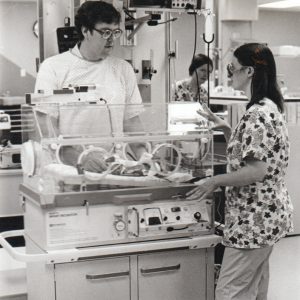calsfoundation@cals.org
Maternal and Infant Mortality
Maternal and infant mortality are global indicators of community health that require highly contextualized solutions. Maternal mortality refers to deaths that occur during pregnancy, childbirth, and the postpartum period. The maternal mortality rate (MMR) is a yearly measure of maternal deaths per 100,000 live births. The infant mortality rate (IMR) measures the annual death rate of live-born infants under the age of one. In the twenty-first century, both the nation as a whole and the state of Arkansas struggle to address maternal and infant mortality effectively.
Few records of infant and maternal mortality rates survive from before the early twentieth century. Late nineteenth-century estimates suggest that fifteen to twenty percent of infants under one year of age died from infectious diseases and other causes. Common causes of maternal death were puerperal sepsis, hemorrhage, and eclampsia.
Appointed in 1916, the Arkansas Medical Society’s Committee on Infant Welfare worked to “create as much [physician] interest as possible” in infant mortality and prenatal care.
Supported by the federal Children’s Bureau, the Sheppard-Towner Act of 1921 provided federal matching funds to states for instruction in maternal and infant healthcare. In the 1920s, Arkansas officials used Sheppard-Towner funds to conduct statewide child health screening clinics, establish a public health nursing staff, and begin midwife training.
The twentieth-century introductions of better public health measures, antibiotics, new vaccines, rehydration therapy, and blood transfusions improved maternal and infant survival. As the national MMR declined, Arkansas’s MMR fell from 208.2 deaths per 100,000 live births in 1948 to 56.7 deaths in 1960.
In the United States, disproportionately high rates of African American maternal and infant deaths are a longstanding consequence of systemic racism. Between 1968 and 1970, Arkansas’s MMR averaged 18.4 deaths per 100,000 live births for whites and 64.9 for all other races. In 1967, the state’s IMR was 20.5 deaths per 1,000 live births for whites and 34.2 for all other races.
The 1960s saw the establishment of Neonatal Intensive Care Units (NICUs) to care for critically ill infants. Established in 1980, Arkansas Children’s Hospital’s NICU provides the state’s highest level of care.
In the twenty-first century, the American MMR is the highest in the developed world. Black mothers and their babies continue to experience high death rates. Since 1999, while the national IMR declined, the overall MMR rose. The leading causes of pregnancy-related death, which is defined as a person’s death either during pregnancy or within one year postpartum, are mental health conditions (including severe postpartum depression), hemorrhage, and heart conditions. Many of these deaths are preventable. In 2020, the leading causes of infant mortality were birth defects, preterm birth, and sudden infant death syndrome (SIDS).
In 2021, Arkansas’s MMR of 43.5 deaths per 100,000 live births and IMR of 8.5 deaths per 1,000 live births were the highest and the third highest in the nation, respectively. The disparities in MMRs between Black and white Arkansans remain. Between 2013 and 2017, Arkansas’s MMR for African Americans averaged 76.3 per 100,000 live births compared to an average rate of 41.8 for whites. High rates of poverty, a lack of universal health insurance coverage, poor rural access to the most advanced medical facilities, and a high incidence of preexisting chronic maternal health conditions contribute to the state’s poor outcomes.
To improve their birthing experiences, African American women organized on behalf of themselves and their communities. Founded in 1988 by Arkansan Kathryn Hall-Trujillo, the Birthing Project USA is a global pregnancy-related support network for Black women. Operating primarily in southeastern Arkansas, the Arkansas Birthing Project connects African American women with mentors who provide assistance during and after pregnancy. Organized in 2018, the Ujima Maternity Network, based in Conway (Faulkner County), trains Black midwives, doulas, and lactation consultants to serve throughout the state.
Founded in 2010, the Every Mother Counts (EMC) organization works to improve maternity care worldwide. In 2022, a short film in EMC’s Giving Birth in America series documented the birth experiences of three women in Arkansas, emphasizing the importance of postpartum care.
The maternal health crisis revived states’ interest in Maternal Mortality Review Committees (MMRCs). Established in 2019, the Arkansas Maternal Mortality Review Committee (ARMMRC) is composed of volunteer medical professionals who review all pregnancy-related deaths and develop strategies to reduce maternal and infant mortality.
In 2020, Medicaid funded forty-four percent of the births in Arkansas. The American Rescue Act of 2021 allows states to extend Medicaid coverage for postpartum care from the federal minimum of two months to a full year. During the 2023 session of the Arkansas General Assembly, Republican state representative Aaron Pilkington of Knoxville (Johnson County) offered a bill designed to extend Arkansas’s postpartum Medicaid coverage to twelve months, but it died in committee. Governor Sarah Huckabee Sanders personally opposed such an expansion but did sign, on March 6, 2024, an executive order to establish a committee to address the state’s shortfalls in maternal health. A report released by the March of Dimes in September 2024 classified more than half of the counties in Arkansas as “maternity care deserts.”
Since 2022, when the state’s “trigger law” made abortion illegal in Arkansas following the overturning of the U.S. Supreme Court’s Roe v. Wade decision, three hospitals have ended labor and delivery services. Ashley County Medical Center in Crossett (Ashley County) and Bradley County Medical Center in Warren (Bradley County) stopped delivering babies in November 2023, followed by Unity Health Newport in Newport (Jackson County) in August 2024. Such closures of labor and delivery units have occurred across the United States, especially in rural areas, and correlate to higher rates of maternal and infant mortality. By March 2025, the Arkansas Center for Health Improvement had identified only thirty-three hospitals in the state that provided labor and delivery services; sixty percent of rural hospitals did not provide such services.
During the 2025, legislative session, the Arkansas General Assembly passed, and Gov. Sanders signed, a bill to make it easier for pregnant women to enroll in Medicaid, in addition to allowing Medicaid to pay for doulas and other services. However, the bills also shortened the statute of limitations in which a plaintiff can bring a lawsuit on behalf of a child who suffered medical injuries during birth.
The American maternal health crisis is a reminder that past progress is fragile. The challenge for policymakers is to develop and implement policies that ensure all patients’ access to equitable and comprehensive maternal and infant health care services.
For additional information:
Alexander, Loretta. “Postpartum Care in Arkansas: A Crisis of Coverage.” Arkansas Advocates for Children and Families, May 11, 2022. https://www.aradvocates.org/publications/postpartum-care-in-arkansas-a-crisis-of-coverage/ (accessed February 3, 2024).
Arkansas Center for Health Improvement. “For Maternal Health Awareness Day, ACHI Highlights State’s Rock-Bottom Ranking.” https://achi.net/news-releases/for-maternal-health-awareness-day-achi-highlights-states-rock-bottom-ranking/ (accessed February 3, 2024).
Centers for Disease Control and Prevention. “Achievements in Public Health, 1900–1999: Healthier Mothers and Babies.” Morbidity and Mortality Weekly Report 48 (October 1, 1999): 849–858.
Centers for Disease Control and Prevention. “Four in 5 Pregnancy-Related Deaths in the U.S. Are Preventable.” https://www.cdc.gov/media/releases/2022/p0919-pregnancy-related-deaths.html#print (accessed February 3, 2024).
Centers for Disease Control and Prevention. “Infant Mortality.” https://www.cdc.gov/reproductivehealth/maternalinfanthealth/infantmortality.htm (accessed February 3, 2024).
Every Mother Counts. “Giving Birth in America: Arkansas: Screening and Advocacy Guide.” https://everymothercounts.org/wp-content/uploads/2022/12/GBA-Arkansas-Toolkit-FINAL.pdf (accessed February 3, 2024).
Glover, CaSandra. “Report: The Critical State of Black Women’s Health, April 12, 2022.” Arkansas Advocates for Children and Families. https://www.aradvocates.org/publications/report-the-critical-state-of-black-womens-health (accessed February 3, 2024).
Gowen, Annie. “This State Calls Itself the ‘Most Pro-Life.’ But Moms There Keep Dying.” Washington Post, August 27, 2024. https://www.washingtonpost.com/nation/2024/08/27/arkansas-maternal-mortality-rate-abortion-ban/ (accessed August 27, 2024).
Hennigan, Mary. “Arkansas Won’t Hear Bill to help New Moms on Medicaid as Maternal Mortality Rates in America Worsen.” Arkansas Times, April 6, 2023. https://arktimes/arkansas-blog/2023/04/06/arkansas-wont-hear-bill-to-help-new-moms-on-medicaid-as-maternal-mortality-rates-in-america-worsen (accessed February 3, 2024).
Hoyert, Donna L. “Maternal Mortality Rates in the United States, 2021.” National Center for Health Statistics. https://dx.doi.org/10.15620/cdc:124678 (accessed February 3, 2024).
“Infant Welfare Committee Report.” Journal of the Arkansas Medical Society 16 (June 1919): 37.
Leavitt, Judith Walzer. Brought to Bed: Childbearing in America, 1750–1950. Oxford: Oxford University Press, 1986.
Ly, My. “Infant Mortality up after Abortion Bans.” Arkansas Democrat-Gazette, February 18, 2025, pp. 1B, 2B. Online at https://www.arkansasonline.com/news/2025/feb/17/study-arkansas-sees-increase-in-infant-mortality/ (accessed February 18, 2025).
———. “Maternity Care Falls Short in 38 Counties.” Arkansas Democrat-Gazette, September 11, 2024, pp. 1A, 6A. Online at https://www.arkansasonline.com/news/2024/sep/10/march-of-dimes-report-lists-more-than-half-of/ (accessed September 11, 2024).
———. “Maternal Health Plan Presented to Sanders.” Arkansas Democrat-Gazette, September 6, 2024, pp. 1A, 3A. Online at https://www.arkansasonline.com/news/2024/sep/05/committee-created-by-gov-sanders-makes/ (accessed September 6, 2024).
“Maternal and Infant Health.” Arkansas Center for Health Improvement. https://achi.net/maternal-infant-health/ (accessed March 13, 2025).
McCoy, Caroline. “Maternal Health in Arkansas: The Doula Effect.” Oxford American, March 5, 2025. https://oxfordamerican.org/oa-now/maternal-health-in-arkansas-the-doula-effect (accessed March 11, 2025).
———. “Sanders Creates Committee on Maternal Health.” Arkansas Democrat-Gazette, March 7, 2024, pp. 1A, 10A. Online at https://www.arkansasonline.com/news/2024/mar/06/sanders-creates-panel-aimed-at-improving-maternal/ (accessed March 7, 2024).
Meckel, Richard A. Save the Babies: American Public Health Reform and the Prevention of Infant Mortality, 1850–1929. Baltimore, MD: Johns Hopkins University Press, 1990.
Miller, Elissa Lane. “From Private Duty to Public Health: A History of Arkansas Nursing, 1895–1954.” PhD diss. Memphis State University, 1989.
Savage, Ashley. “Film Spotlights Health Stories of State’s Moms.” Arkansas Democrat-Gazette, May 1, 2023, pp. 1B, 3B. Online at https://www.arkansasonline.com/news/2023/may/01/driving-down-arkansas-high-maternal-mortality/ (accessed March 13, 2024).
———. “Nonprofit Keys on State Maternity.” Arkansas Democrat-Gazette, April 23, 2023, pp. 1B, 4B. Online at https://www.arkansasonline.com/news/2023/apr/23/film-on-arkansas-high-maternal-mortality-rate-set/ (accessed March 13, 2024).
U.S. Department of Health, Education and Welfare, Public Health Service, Vital Statistics of the United States 1970, Volume II: Mortality Part A. https://www.cdc.gov/nchs/data//vsus/mort70_2a.pdf (accessed February 3, 2024).
Vrbin, Tess. “Black Maternal Mortality in Arkansas Rose 110% in Two Decades, Study Shows.” Arkansas Advocate, July 3, 2023. https://arkansasadvocate.com/2023/07/03/black-maternal-mortality-in-arkansas-rose-110-in-two-decades-study-shows/ (accessed February 3, 2024).
Melanie K. Welch
Mayflower, Arkansas
 Health and Medicine
Health and Medicine Arkansas Children's Hospital
Arkansas Children's Hospital  Rick Nestrud in NICU
Rick Nestrud in NICU 



Comments
No comments on this entry yet.